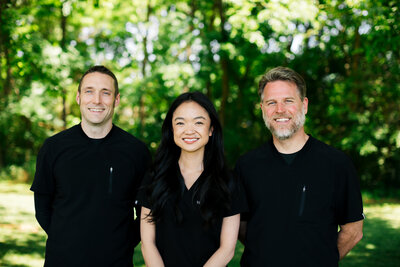 If you are in need of dental implant restoration in Murfreesboro, TN and surrounding areas, Dr. Mark Connolly with Three Rivers Family Dentistry has the experience and technology to help you. Restore your smile with single-tooth implants where your tooth/teeth are currently missing. Restorative implants are surgically placed. An artificial tooth root is implanted in an opening created by our dentist. This root fastens itself to your jawbone and then a crown is placed on top. Dental implants are favored over bridges and dentures as they are seen as a permanent and aesthetic solution to the problem of missing teeth. Plus they are strong and durable and fit in well with a busy lifestyle. The term ‘restoration’ is used to refer to a false tooth. This tooth is then attached to the implant and looks and behaves in the same way as a natural tooth. Dental implants look and feel like your real teeth and can improve the confidence you have in your smile. Dental implants give you the ability to have a permanent fix to your smile, overall oral hygiene and appearance.
If you are in need of dental implant restoration in Murfreesboro, TN and surrounding areas, Dr. Mark Connolly with Three Rivers Family Dentistry has the experience and technology to help you. Restore your smile with single-tooth implants where your tooth/teeth are currently missing. Restorative implants are surgically placed. An artificial tooth root is implanted in an opening created by our dentist. This root fastens itself to your jawbone and then a crown is placed on top. Dental implants are favored over bridges and dentures as they are seen as a permanent and aesthetic solution to the problem of missing teeth. Plus they are strong and durable and fit in well with a busy lifestyle. The term ‘restoration’ is used to refer to a false tooth. This tooth is then attached to the implant and looks and behaves in the same way as a natural tooth. Dental implants look and feel like your real teeth and can improve the confidence you have in your smile. Dental implants give you the ability to have a permanent fix to your smile, overall oral hygiene and appearance.
Give Three Rivers Family Dentistry a call today or fill out our online form to schedule an appointment.
615.907.3456
Restoration Of Crowns

An implant restoration can involve a single tooth or several teeth, many of which can be attached to a single implant. The implant is inserted into the jaw and allowed to fuse with the bone in a process called osseointegration. This process takes anywhere from 3 to 6 months.
Once the gum has healed and fusion has taken place the implant is then ready for the attachment of a metal abutment. This device acts as an anchor for the restoration. There are several types of abutments which are designed to blend in with your natural teeth. Dr. Connolly will take an impression of your teeth using a mould which contains dental putty. You will be asked to bite into this putty so that he has an imprint of your teeth. This impression is sent to a laboratory for them to produce your new restoration. You will be fitted with a temporary restoration during this time.
Restoration Of A Bridge
The process is the same as mentioned above but with one difference. This involves the creation of several crowns which are then fixed to a bridge. A bridge consists of a false tooth known as a pontic and two or more crowns (restorations) which are attached to either side of it. This bridge slots into the space between your teeth caused by tooth loss and is supported by the other teeth. The big difference between this and ordinary dentures is that a fixed bridge is cemented in place and cannot be removed each night. We complete all dental bridge work here at our location in Murfreesboro, TN.
Restoration Of An Implant Retained Denture

A denture is a device worn in the mouth to replace missing teeth. It can replace a few or all of your teeth. It consists of a plate with artificial teeth (restorations) attached to it and is worn on a daily basis. But one of the problems with a denture is that of clicking noises or shifting around in the mouth. There are people who have badly fitting dentures or find that they have become lose, often due to changes in their jaw as part of the ageing process. One solution is a denture which is fixed in place with a dental implant. This is similar to a fixed bridge and removes the need to remove the dentures at night for soaking before replacing them in the morning. The advantages of an implant retained denture are the reduced risk of trapped food particles underneath the plate which can lead to an infection: no risk of sores developing caused by friction of the denture: strong and lifelike: plus this is customised to your individual requirements.




Be the first to comment